BOOK REVIEWS, NOTES AND COMMENTS
Edited by Federica Napolitani Cheyne

APPLICATION OF THE INTERNATIONAL CLASSIFICATION OF FUNCTIONING, DISABILITY
The experience in Italy since 2001
Disability and Rehabilitation, vol. 31, Suppl. 1
Matilde Leonardi, Carlo Francescutti, Andrea Martinuzzi, Dave Muller (Ed.).
International Society of Physical and Rehabilitation Medicine.
London: Informa Healthcare; 2009, 173 p. ISSN 0963-8288.

ICF E CONVENZIONE ONU SUI DIRITTI DELLE PERSONE CON DISABILITÀ
Nuove prospettive per l'inclusione
Giulio Borgnolo, Romolo de Camillis, Carlo Francescutti, Lucilla Frattura, Raffaella Troiano, Giovanni Bassi, Elena Tubaro (Ed.)
Gardolo (TN): Edizioni Erickson; 2009, 211 p. ISBN 978-88-6137-499-7.
In 2001 the World Heath Organization (WHO) set up the International Classification of Functioning, Disability and Health (ICF). ICF was intended to replace the traditional - i.e., mainly or exclusively medical-pathological - view of disability conditions with a broader view considering the complex interactions between the subject's physical/mental state and the social and environmental context in which the person lives. The ultimate aim of ICF is to improve the assignment of persons to the most effective services and to the most appropriate benefits, in order to minimize the adverse consequences of their disability. Initiatives based on ICF and its version for children and youth (ICF-CY) were soon started in Italy, either ex novo or as modifications of programs started at an earlier time. Several national and local institutions participate in this work, of which a substantial part is coordinated by the Friuli-Venezia Giulia (FVG) Health Agency, acting as WHO Italian Collaborating Centre for the Family of International Classifications. The special 2009 issue of the journal "Disability and Rehabilitation" is devoted to an impressive array of contributions aimed at analyzing various aspects of ICF application in Italy (20 papers of varying length are framed by a foreword and four specific editorials).
The more extensive paper is devoted to a detailed revision, coordinated by ISTAT, of Italian disability statistics according to ICF criteria. This work has already contributed to an improved integration of various sources of information; it also shows the need for considerable further efforts to improve data quality and their impact on the practices of services. Most of the other contributions deal with ICF application in many different conditions and contexts, ranging from assessments of school populations to a wide variety of pathological conditions in children, adults and ageing people. Many of these are specific neurological conditions, including consequences of traumas, while one of the papers deals with disability caused by obesity and another one with psychiatric disability and rehabilitation. Given the large number of different conditions considered and the specific features of the ensuing disability states, it is obviously impossible to give further details in a brief review. One of the editorials provides a connection with the volume which deals with ICF in relation to the December 2006 UN Convention on the rights of persons with disabilities. The convention was endorsed by Italy in March 2007 and more recently ratified by the Italian Parliament (law n. 18 of March 3, 2009). In other words, it is now the Law of the Land; therefore, any non-observance of its provisions should be dealt with like any other illegal act or omission - but in today's climate this is obviously wishful thinking (see below). The volume starts with an illustration of the relations between the UN Convention (full text in Appendix 1) and ICF, including the use of the latter for monitoring how the Convention is implemented. Subsequent chapters are devoted to specific problems, like those encountered in schools and in work environments, with a laudable emphasis on aspects long neglected, such as the need to consider criteria of justice and subjective well-being. A paper from ISTAT again shows the difficulty of obtaining data of uniform reliability; anyway, it concludes that as in other EU countries disabled people constitute about 11% of the Italian population - a formidable burden indeed if therapeutic and support measures, both specific and nonspecific, as well as appropriate benefits, must be made available to all according to real needs. The last chapter, from the team for Health and Disability Evaluation of the FVG Agency, analyzes the rationale and operational features of a national project involving eight Italian Regions, which is aimed at formulating uniform ICF-based protocols for the evaluation of disability. In summary, these two publications testify of a dense and effective network of qualified initiatives aimed at producing the know and the know-how which is badly needed to cope with the problems of six-seven million disabled Italians. Which kind of response do we give today to their needs? The Corriere della Sera of 7 March 2010 (p. 62) gives a brief summary of the last report of the National Coordination of Chronically Sick People Associations, issued by Cittadinanza Attiva (Active citizenship movement). If you ask disabled people whether or not they have access to adequate rehabilitation measures; whether or not they know about some interdisciplinary ad hoc equipe; whether or not they find some help when they need to move far from home; whether or not they have prompt access to a hospital or other appropriate structure in case of urgent need, and so on, 60-70% of the responses are "No". A final remark. In the streets of most central and northern European cities, the number of severely disabled persons who move around with (or aboard) an appropriate aid, but without any assistance, is much larger than in most Italian cities - the opposite of what one would expect on the basis of differences in climate and average distances. In our cities disabled people, unless they have one or more persons to help them, don't dare to move from their home (or from the rest home or other place of hospitalization): since it is often impossible to find a bus or streetcar with a functioning platform for wheelchairs (not to speak of the survival of innumerable "architectural barriers"); while sidewalks and zebra crossings are permanently blocked by illegally parked cars and motor cycles, plus unlicensed coffee-shop or restaurant tables (not to speak of dog excrements and bulky litter - broken pieces of furniture, discarded household appliances, even heaps of masonry debris). Therefore, the problem of doing justice to the disabled is not only a problem of inadequate know-how and resources to meet their needs, but also - perhaps most of all - a problem of delayed civic and cultural evolution of our healthy majority.
Giorgio Bignami
già Dirigente di ricerca presso l'Istituto Superiore di Sanità, Rome, Italy welin.bignami@mclink.net
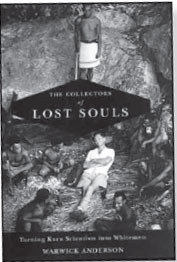
THE COLLECTORS OF LOST SOULS
Turning kuru scientists into whitemen
Warwick Anderson. Baltimore: The John Hopkins University Press; 2008. 318 p. ISBN-13:978-0-8018-9040-6.
Warwick Anderson in his recent book The collectors of lost souls reports his view on the history of kuru field research in the second half of the XX century. Anderson revised an incredible amount of documents and interviewed many scientists and anthropologists who participated to this fascinating chapter of research that changed our view on the etiology of kuru and other neurodegenerative disorders affecting people worldwide.
Kuru disease and the complex social events related to the Fore believing that it was caused by sorcery killed about fifty per cent of the population living in the highlands of Papua-New Guinea in the past century. Though the kuru plague was recognized in the 30s by the gold prospector Ted Ubank and better reported during the field work of the Australian anthropologists Ronald and Catherine Berndt in the early 50s, it was not until the arrival a few years later of the American pediatrician Carleton D. Gajdusek in the Fore territory that the disease was brought to the attention of the international scientific community.
Gajdusek, with the invaluable help of Vin Zigas, district medical officer in the Fore tribe region, quickly reported a detailed clinical and epidemiological analysis of 114 kuru patients in the prestigious New England Journal of Medicine. After a few weeks of a prodromal phase where the patients referred of headache, pains, and loss of weight, kuru patients presented with an evident cerebellar syndrome characterized by difficulties in walking, tremor ("kuru" in the Fore language), other involuntary movements, and dysarthria. Later they stand only with the help of a stick, then can not stand even with help, and finally become also incapable to remain sit. In the terminal stage the patient is bedridden, dysphasic, and eventually succumbs in a state of starvation. Often kuru patients display emotional changes such as inappropriate euphoria (they often laugh without a reason) or apprehension but do not show evident cognitive signs until late during the course of disease.
Kuru disease affected mostly women and children because they were almost exclusively participating to the eating of relatives as part of a mourning ritual where men were excluded. Though the mechanism of spread of kuru in the Fore people is clear, when and how kuru disease had started remains unsolved. Eating relatives, though unacceptable for us, it would not cause disease unless human "food" contains prions, the causative agent of kuru and other transmissible spongiform encephalopathies. A similar conundrum applies to the more recent prion epidemic in the cattle population where a sort of forced industrial "cannibalism" caused the spread of bovine spongiform encephalopathy (BSE) but where the origin of the disease remains still unsettled. The most plausible explanation for the origin of kuru was the occurrence of a form of sporadic Creutzfeldt-Jakob disease in the Fore population as for BSE was the contamination of foodstuff with the scrapie agent, but these hypothesis remain pure assumptions.
Several other books have been written on the history of kuru research, likely because people is often more intrigued to the amazing story of scientists running into the bushes populated by cannibals rather than to the importance of the scientific discovery made by Gajdusek and his numerous colleagues in the US National Institutes of Health and elsewhere. The story of kuru research was complex and many different expertise where put together to solve the puzzle of kuru epidemics. However, the geniality and the determination of Carleton Gajdusek in conducting his research among the Fore people and in instructing his people in the laboratory was extraordinary. Gajdusek, however, was not a saint. He was an obsessive and egocentric person with some obscure aspect of his personal life as it was reported by Warwick in his book, but he was a great scientist and without him it is likely that Creutzfeldt-Jakob disease would have never been recognized as a prion disease and that the occurrence of variant Creutzfeldt-Jakob disease would have never been linked to the bovine spongiform encephalopathy epidemic in the UK. Gajdusek may have used unorthodox behavior (for our current thinking) in collecting brain and tissues from the Fore people but he did that with the aim to help them, to understand the disease, and finally to relieve the people from the kuru plague. The insinuation that Gajdusek has used tissues and body fluids taken from the Fore people to distribute them all over the world for his personal interest is unacceptable and this part of the story that Warwick explicitly did not say in his book but that transpires between the lines I found not pleasant nor suitable to the figure of Gajdusek I had the honor to work with.
Maurizio Pocchiari
Dipartimento di Biologia Cellulare e Neuroscienze Istituto Superiore di Sanità, Rome, Italy Maurizio.pocchiari@iss.it
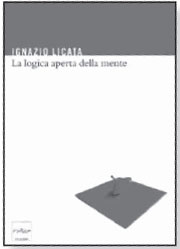
LA LOGICA APERTA DELLA MENTE
Ignazio Licata. Torino: Codice Edizioni; 2008.
ISBN 978-88-7578-090-6. 22,00.
The most salient feature of phase transitions is the generation of correlations spanning the entire system so encompassing different temporal and spatial scales while in the standard situations each interaction remains confined into its specific characteristic scale. Analogously to the turbulences invading the entire volume of a boiling fluid, where molecular interactions emerge to the macroscopic scale, in these years science is passing through a deep revolution so that knowledge cannot anymore be constrained into the boundaries of established disciplines and any sensible approach to a scientific matter immediately crosses its boundaries. La logica aperta della mente is thus only at a first sight a cognitive sciences book, mind/brain relations and other classical puzzles of neurosciences are only the initial point to face the great theme of the nature of our knowledge of the world. We could call it an epistemology book, but is not the classical (and often boring ) philosophical treatise with the old apparatus of "scientific revolution", "paradigms" and "falsifiable statements" written by philosophers that did never step into a real laboratory. Ignazio Licata is a physicist and tells us about the difficulties we meet when looking for a consistent and reliable model of the functioning of the mind. Here the focus is on real representation problems and not on philosophical principles. In so doing the author travels along the entire spectrum of science in the only open and reliable highway: the methodological one that connects biochemistry to physics, psychology, cell biology, by the fact we (as human beings) approach the world outside with the same basic attitudes. Thus investigation tools and tricks used in different fields, besides their differences, share a common essence Licata unveils when considering the strengths and limitations of different approaches to the study of cognitive sciences. This book can be considered as a manual, in the strict etimological sense of something we can put our hands on so to have a suggestion on the best way to represent something in a meaningful way.
This precious book stems from the crisis that in these last one hundred years invested scientific speculation definitively eliminating the positivist faith in the objective character of scientific knowledge progressively accumulating pieces of evidence in an ordered manner along a linear path to the definitive truth. On the contrary science appeared as a fully humanistic enterprise whose "path to the truth" (the author is fully aware of both the existence of truth and the need of a continuous search of it and criticizes the post-modern "anything goes" relativistic attitude) is the same path of art, so that we can grasp pearls of truth from a Giotto as well as from a Van Gogh painting, being the truth linked to the scientist (artist) choice of perspective allowing for the best fit to reality (Adaequatio intellectus et rei according to the St. Thomas the Aquinas definition of science).
Along this line the use of quantum mechanics derived formalism that Licata, as a theoretical physicist, suggests for modeling the abrupt surge of novelty and change in the cognition is extremely interesting: this suggestion does not stem from the consideration of brain as a quantum device but simply because physicists studying microphysics had to develop conceptual tools to get rid of the abrupt discontinuities and singularities they met in their investigation field so that the same tools can be of use to model the discontinuities we meet in psychology and cognitive sciences. In doing so Licata puts in the center of the stage the creative work of the scientist engaged into a realistic (even if forcedly partial) representation of the mechanisms of cognition revealing to the readers the basic fallacy of the reductionist temptations to look for the "ultimate explanations" in improbable "tought machines" (the demolition of magnetic resonance brain mapping as the ultimate model of mind is one of the best parts of the book) or in the search for "mind genes". Simply Licata explains us how the identification of the mind with the brain is like looking for the music observing the composition of an orchestra. The music (as the mind) can only emerge from the interaction between the machinery with the environment so to give rise to something different from both of the actors in the same way like the music s something different from both the orchestra and the music score.
This book probably cannot be read before going to sleep, it deserves a certain degree of attention and application, nevertheless Licata completely avoids the use of mathematical formalism and has a very fluent and captivating style. I'm convinced it can be appreciated by a vast range of readers going from the scientists to the students at Universitary level of different matters, personally I suggest to try and go into the reading with the consciouness that, even if we miss some elements of the explanations, we will sure carry home the basic message.
Alessandro Giuliani
Dipartimento di Ambiente e Connessa Prevenzione Primaria Istituto Superiore di Sanità, Rome, Italy alessandro.giuliani@iss.it
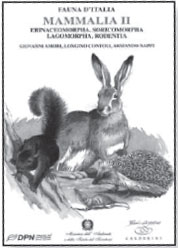
MAMMALIA II
Erinaceomorpha, Soricomorpha, Lagomorpha, Rodentia. Fauna d'Italia.
Vol. XLIV Giovanni Amori, Longino Contoli, Armando Nappi.
Direzione per la Protezione della Natura. Ministero dell'Ambiente e della Tutela del Territorio. Milano: Edizioni Calderini; 2008. 736 p.
ISBN 978-88-506-5302-7.

I MAMMIFERI DELLA PROVINCIA DI ROMA
Dallo stato delle conoscenze alla gestione e conservazione delle specie. Provincia di Roma, Assessorato alle Politiche dellAgricoltura.
Giovanni Amori, Corrado Battisti, Stefano De Felici (Ed.)
Roma: Stilgrafica; 2009. 347 p.
ISBN 978-88-9537103-0.
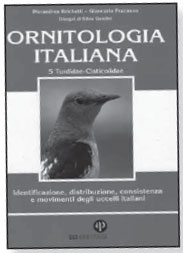
ORNITOLOGIA ITALIANA
Identificazione, distribuzione, consistenza e movimenti degli uccelli italiani.
Vol. 5 Turdidae - Cisticolidae. Pierandrea Brichetti, Giancarlo Fracasso.
Bologna: Oasi Alberto Perdisa Editore; 2008. 429 p.
ISBN 978-88-8372-455-8.
This journal (Annali dell'Istituto Superiore di Sanità) is a public health periodical attempting to reach the widest international readership as practically all biomedical and non biomedical journals aspire to. However, since its origin in the late 1930s, as Rendiconti dell'Istituto Superiore di Sanità, it was intended to function as a showcase of Italian scientific contributions, making them (editorially) available at the international level. To this purpose, we have been reviewing, rather regularly, books and essays written in Italian: firstly, to encourage their translation by international ornon-Italian publishing houses - but also, to make scientists aware of the material available on the Italian scientific books market.
Since about twenty years, an increasingly relevant issue regards endocrine disrupting chemicals (EDCs), manmade agents possibly interfering with neuroendocrine, and sometimes neuroimmune systems. Among the commonest strategies to detect EDCs presence in the environment, is the use of "sentinel populations" of wild animals, particularly vertebrates: it is the subject of a dedicated volume [1] intended for students, experts, and even forest rangers. Sentinel populations are based on a zoogeographical perspective, i.e., regularly monitoring the presence/disappearance/rarefaction of selected vertebrate species, vulnerable and sensitive to EDCs: by damaging their reproductive system through hormonal dysregulation, in fact, EDCs inhibit reproductive success, in some cases leading to sudden disappearance of entire localised populations. To date, in this Journal we regularly reviewed books dealing with the following vertebrate groups: Mammals (Mammalia), Birds (Aves), Reptiles (Reptiles), Fishes (Teleostei) [1-3].
The Class of Mammals includes the Order of Primates, and among its about 370 species [4], Homo sapiens. Such phylogenetical proximity renders natural populations of mammals particularly interesting in terms of sentinel species rarefaction or disappearance. Being so closely related to humans (and, in some cases, even part of the human food chain), makes mammals such as rabbits and hares, hedgehogs and porcupines worth being considered for EDCs detection. Those two recent books review the status and the available knowledge about mammals in Italy.
The first one, edited by Amori et al. (Gianni Amori is one of the most authoritative Italian mammologists, and CNR-based senior scientist), and co-signed also by Longino Contoli, is the 46th volume of La fauna d'Italia, an encyclopaedic series sponsored by the Ministero dellAmbiente e Tutela del Territorio: it concerns four taxonomic groups. One of them, Lagomporpha, includes edible species. Another group, Rodentia, is of paramount importance for ecotoxicology, since Muridae - such as rats and mice, the commonest mammalian laboratory species - may allow close comparison between laboratory-detected neuroendocrine change caused by experimental exposure to EDCs on the one hand, and EDCs-due changes on the structure, composition and density of natural populations of Italian rodents.
More interestingly for urban ecotoxicologists, the volume I mammiferi della provincia di Roma (again by Giovanni Amori and colleagues) reviews mammals of "Roma e provincia". Such an atlas covers both the urban Rome central area and fragmented habitats in suburbs, up to Mediterranean coastlines on the West, and Appenninic environments on the East. Mice and rats, of course, are here carefully considered, as well as very fragile species, such as insect- eating bats and shrews, and edible species, such as hares, wild rabbits, hedgehogs and porcupines, the two latter considered for decades as a delicatessen sen in central Italy. This book also covers important toxicological issues, such as a survey of the trophic system of Strigiformes/small rodents, atlas studies to evaluate beta-diversity, alloctonous and alien species, murine pest control, or habitat fragmentation of "focal" species. Of particular interest are Carlo Rondinini and Luigi Maiorano's remarks on species distribution and planning of conservation strategies, and Paolo Agnelli (La Specola Museum, Florence) et al. intelligent designing of innovative conservation strategies for complex networks of bat species.
It is worth mentioning that other book series, dealing with the vertebrate Class Birds (Aves) already enlisted five volumes Ornitologia italiana. Identificazione, distribuzione, consistenza e movimenti degli uccelli italiani by Brichetti P, Fracasso G. Together with an original website attempting to monitor bird presence and distribution in Italy and Switzerland, they are both of interest to provide information about sensitive species to EDCs in environments where unknown pollutants may pose risks to sympatric human populations, particularly in the case of vulnerable subjects such as pregnant women, children and aged or diseased subjects.
Enrico Alleva and Fiorenza Gracci
Istituto Superiore di Sanità, Rome, Italy alleva@iss.it
REFERENCES
1. Alleva E, Francia N, Olivieri N, Santucci D. La specie sentinella. Bologna: Bonomia University Press; 2004.
2. Santucci D, Francia N, Alleva E. Montagna e salute. Bologna: Bonomia University Press; 2006. p. 29-35.
3. Bologna MA, Salvi D, Pitzalis M. Atlante degli anfibi e dei rettili. Roma: Gangemi Editore; 2007.
4. Wilson DE, Reeder DM (Ed). Mammal species of the world. 3rd ed. Johns Hopkins University Press; 2005.
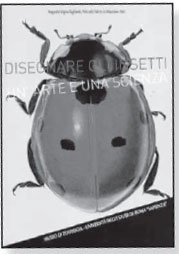
DISEGNARE GLI INSETTI
Un'arte e una scienza
Augusto Vigna Taglianti, Niccolò Falchi, Maurizio Mei.
Roma: Museo di Zoologia, Università degli Studi di Roma "La Sapienza"; 2009. 76 p.
Una nuova mostra, avente per titolo "Disegnare gli insetti, un'arte una scienza" si è tenuta nel 2009 presso il Museo di Zoologia dell'Università degli Studi "Sapienza" di Roma, nella sede di Entomologia del Dipartimento di Biologia Animale e dell'Uomo.
II Catalogo della mostra, prodotto a curadi Augusto Vigna Taglianti, Niccolò Falchi e Stefano Mei merita un commento sulle opere riportate ed una riflessione di carattere più generale sull'argomento.
II compito è facilitato dagli organizzatori della mostra che, molto opportunamente, hanno chiesto ai disegnatori invitati, di aggiungere nel Catalogo qualche idea personale sul significato del disegno entomologico.
Dai disegni inclusi nel Catalogo della mostra, dalla lettura dei vari commenti degli autori dei disegni e dai loro "curricula", si evince subito che vi sono rappresentati due categorie di disegnatori, una costituita da artisti di professione e/o allievi di licei artistici o di accademia interessati anche agli insetti, e l'altra rappresentata da entomologi che ad un certo momento hanno affrontato personalmente la rappresentazione grafica di un insetto.
In effetti il problema dell'illustrazione di un insetto si impone prima o poi a tutti gli entomologi, che per risolverlo hanno due possibilità: rivolgersi a dei bravi disegnatori, oppure eseguire personalmente il disegno. Nel primo caso si avranno disegni tecnicamente perfetti, ma non sempre utili per stabilire l'identità specifica" e più o meno belli a seconda
dell'abilità al disegno dell'entomologo.
I disegni di Gea d'Este, Patrizio Di Sciullio, Niccolò Falchi, Gianni Gobbi e Mario Sturani appartengono al gruppo degli artisti che attratti dalla bellezza degli insetti si sono dedicati a rappresentarli graficamente; tra questi primeggia M. Sturani che oltre a disegnare l'insetto (Coleotteri, Carabidi) ha rappresentato anche l'ambiente circostante.
Al gruppo degli entomologi che si sono cimentati nel disegno e sempre con eccellenti risultati appartengono i disegni di Franco Mason, Maurizio Mei, Mark Russel, Dante Vailati, Filippo Venturi e Luciano Santini. Tra questi primeggiano per bellezza artistica i disegni di M. Russel sui Coleotteri Curculionidi e sono anche particolarmente interessanti quelli di M. Mei che rappresentano la morfologia e biologia di alcuni Ditteri, accoppiamento dei Conoidi e parassitismo dei Tachinidi su bruchi di Lepidotteri.
Un discorso a parte meritano i disegni di Leo Rivosecchi e Stefano Zoia, sul piano artistico forse modesti ma importanti sul piano scientifico, perché ricchi di particolari anatomici (organi della riproduzione) utili alla diagnosi di specie. Per tale fine il disegno può perdere le sue caratteristiche artistiche e diventare schematico riducendosi a poche linee che rappresentano ciò che l'Autore ha capito e che intende far capire agli studiosi interessati all'identificazione specifica.
Per inciso vale la pena di ricordare che le ricerche sull'identità specifica si avvalgono oggi di nuove tecnologie, quale la fotografia a scansione, lo studio dei cromosomi politecnici e l'analisi molecolare, ma tutte insieme non riusciranno mai a sostituire il valore del disegno inteso come mezzo indispensabile per consentire l'identificazione di una specie. Anche se in alcuni casi, per altro alquanto rari, occorre riconoscere che la fotografia, anch'essa del resto arte e scienza al tempo stesso, può avere lo stesso valore del disegno ai fini diagnostici.
Chi ha avuto l'opportunità di visitare la mostra avrà avuto modo di apprezzare i memorabili murales di Hitnes rappresentanti giganteschi insetti multicolori sia sul muro esterno che su quello interno del Museo di Zoologia sito in piazza Valerio Massimo a Roma.
Infine occorre ricordare come nel passato anche presso l'Istituto Superiore di Sanità c'era un eccellente laboratorio di disegno, con esperti disegnatori abili anche nel rappresentare insetti. I disegni erano effettuati con una strettissima collaborazione con gli entomologi dell'ISS e quindi utili sia sul piano artistico che su quello scientifico.
Michele Maroli
Dipartimento di Malattie Infettive, Parassitarie ed Immunomediate Istituto Superiore di Sanità, Rome, Italy michele.maroli@iss.it
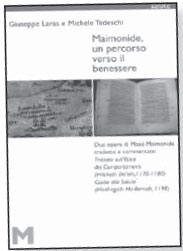
MAIMONID , UN PERCORSO VERSO IL BENESSERE
Due opere di Mosè Maimonide tradotte e commentate
Trattato sull'Etica dei Comportamenti (Hilchoth De'oth, 1170-1180) Guida alla Salute (Hanhagath Ha-Beriuth, 1198)
Giuseppe Laras, Michele Tedeschi Monte San Pietro (BO), Gruppo editoriale Muzzio 2010. 175 p.
ISBN 978-88-96159-31.6 18,00.
Maimonide, chi era costui? E che ci fa sugli Annali la recensione di una scelta di scritti di un filosofo e medico ebraico del 12º secolo? Vediamo allora una prima citazione: "Fra tutti i comportamenti propri dell'uomo ve ne sono alcuni posseduti fin dalla nascita, in base alla natura del proprio corpo; altri che la natura dell'uomo è predisposta a recepire con facilità più di altri atteggiamenti. Vi sono anche altri comportamenti, non presenti nella propria natura, ma appresi da altri, a cui il soggetto si è predisposto autonomamente, sulla base di un pensiero che gli è venuto, o poiché lui ha sentito che è un comportamento buono che è opportuno adottare e che quindi ha adottato fino a farlo suo" (p. 44). Insomma, una puntuale definizione dei rispettivi ruoli di natura, cultura, predisposizione, apprendimento sociale, e quant'altro è ancora oggi argomento di dibattiti spesso rissosi tra etologi e psicologi di varie scuole, biologi dell'evoluzione e linguisti, genetisti e neurobiologi, sociologi e antropologi, filosofi e politici, eccetera.
Mosè figlio di Maimon (Maimonide, ma nel mondo ebraico RAMBAM per Rabbì Moshè Ben Maimon), nasce a Cordova nel 1138. Dieci anni dopo la città cade nelle mani dei raffinati ma poco tolleranti Almohadi, quindi la famiglia parte per un lungo pellegrinaggio attraverso vari paesi: tappe in Marocco e in Israele, stanziamento definitivo in Egitto. A questo punto, ormai, la fama del Nostro è già così vasta che nel 1171 viene nominato Naghid (capo degli ebrei d'Egitto), poi nel 1185 medico ufficiale del Saladino. Scrive solo una parte minore delle sue numerose opere in ebraico, la maggior parte in arabo (ma verrà presto tradotto in ebraico). Muore nel 1204 e viene portato a seppellire a Tiberiade, in Terra d'Israele.
I due sintetici trattati nel presente volume, egregiamente presentati ed editi da Giuseppe Laras - studioso di filosofia ebraica medievale, Rabbino Capo e docente alla Statale di Milano - e da Michele Tedeschi, oncologo e specialista in agopuntura, responsabile delle sperimentazioni cliniche e segretario del Comitato etico alla Humanitas di Rozzano, sono versioni sintetiche di opere filosofiche, psicologiche, mediche e altre assai più ponderose, pertanto accessibili solo a una ristretta cerchia di esperti. Il primo, come si è già visto, è un tesoretto di nozioni psicologiche e di precetti etici; il secondo un manuale di spiegazioni chiare e semplici sulle cause e meccanismi di varie malattie, di precetti igienici, dietetici e medici per curarle e soprattutto per prevenirle: un vademecum approntato dietro specifica richiesta del Saladino, tormentato dalla stitichezza e afflitto da una grave depressione.
Si potrebbero portare molti ulteriori esempi delle approfondite conoscenze di Maimonide in campo psicologico, delle sue raffinate competenze di counseling. Colpiscono in particolare: il suo modo di trattare corpo e mente (anima) come un unicum inscindibile; il suo culto della "medietà" (è altrettanto errato comportarsi come una belva aggressiva e come una pecora succube del primo prepotente di passaggio); la sua valorizzazione di un interculturalismo fondato nella Torah, che prescrive "Amate lo straniero" (Deuteronomio, 10, 19), "Egli [il Signore Santo Benedetto] ama gli stranieri" (ibid. 10, 18) (p. 80-81); la sua condanna della maldicenza soprattutto se mascherata, fatta per vie traverse ("polvere" di maldicenza); i suoi precetti "relazionali" (se un tuo compagno va per una via non buona, in prima battuta ammoniscilo in maniera riservata, con pacatezza e linguaggio dolce, in modo da non farlo vergognare; in caso di recidiva alza un pò i toni; e così via in crescendo in caso di ulteriori recidive).
Questa maestria in campo filosofico e psicologico si combina nel secondo trattatello con le esperte indicazioni di carattere più strettamente igienistico e medico, sempre in base al principio della inseparabilità di corpo e psiche, nella salute così come nella malattia. Certo non mancano passaggi che oggi possono far sorridere: per esempio, certe spiegazioni fisiologiche e fisiopatologiche come quelle sugli Spiriti (lo Spirito Naturale di origine epatica, quello Vitale di origine cardiovascolare e quello Psichico, "il vapore che si trova nelle camere del cervello e che è disseminato da lì attraverso i canali dei nervi", p. 133); o le numerose ricette di incredibile complessità, sia per il numero e la minuziosa specificità dei dosaggi degli ingredienti naturali (un'Appendice di ben 17 pagine elenca circa 200 piante usate a scopo terapeutico nell'ambito della medicina ebraica al Cairo), sia per la fantastica laboriosità delle preparazioni. Ma il testo è anche disseminato di indicazioni che appaiono ancor oggi più che valide, come questo avvertimento che sembra anticipare i deliri di onnipotenza della medicina odierna e i suoi accanimenti terapeutici: "Se la malattia è più forte della forza del paziente, il medico non è di alcun beneficio. Se la forza del paziente è maggiore di quella della malattia, il medico non è per nulla necessario. Ma quando queste sono uguali, allora vi è bisogno di un medico per supportare la forza del paziente e assisterlo nel contrastare la malattia" (p. 138). Un altro avvertimento significativo: le malattie danno spesso segni di sé solo quando sono già in stato avanzato (e Maimoide non aveva certo a disposizione la sterminata letteratura sulla ipertensione o sui tumori in fase preclinica); occorre quindi adottare uno stile di vita idoneo a prevenirle: misure dietetiche (mai mangiare sino alla sazietà; buoni i formaggi freschi e leggeri, patogeno l'abuso di quelli pesanti e stagionati), igieniche, ecologiche e altre - ogni volta minuziosamente specificando.
Di fronte alla odierna medicalizzazione e/o psichiatrizzazione di ogni minimo scarto dal perfetto benessere, di fronte al diluvio universale che ne consegue di analisi di ogni razza e colore e di prescrizioni farmacologiche, appaiono attuali anche le indicazioni di Maimonide sulle patologie iatrogene, contro l'uso ingiustificato di rimedi "forti", contro il ricorso routinario anziché solo eccezionale alla polifarmacoterapia. E così pure, di fronte ai non rari casi di applicazione troppo fiscale delle pur benemerite regole elaborate dall'Evidence based medicine, Maimonide precorre i tempi avvertendo con parole sue che non esiste l' "ammalato medio" pronto a rispondere uniformemente a una data terapia. Anche nell'ambito della stessa malattia esistono piuttosto tanti individui diversi l'uno dall'altro e diversamente reattivi, il che richiede che il medico sappia capire il loro modo di rispondere all'una o all'altra condotta terapeutica.
Infine il cerchio si chiude con le considerazioni sul ruolo delle reazioni emozionali a eventi sia positivi che negativi e al loro ruolo nel continuum salute/ malattia; quindi sull'importanza delle componenti psicologiche nei programmi terapeutici. Per salvaguardare la salute mentale è essenziale apprendere a evitare le infinite ruminazioni sugli eventi negativi del passato (oggi si dice elaborare un lutto), l'eccessivo arrovellarsi sulle possibili avversità del futuro. Per quanto riguarda i curanti, "si dovrebbero selezionare persone che possano tirarlo su [l'ammalato] di morale, servirlo e prendersi cura di lui. Tutto questo è obbligatorio in qualunque malattia". Ma subito dopo, realisticamente: "se un medico è mancante in questo, ognuno si deve organizzare queste cose da sé". Insomma, Maimonide conosce sin troppo bene i suoi colleghi; e pare quasi che nella sfera di cristallo veda certe penose scene odierne di ricovero con corteo di portatori di stoviglie e portapranzo, lenzuola e federe, medicine e cerotti e altri paraphernalia di cui l'ospedale è sprovvisto (oltre al contante per l'assistenza extra in nero, se parenti e conoscenti non ce la fanno a turnare notte e giorno).
Un ultimo avvertimento (questo del recensore), per chi volesse dilettarsi a fare un florilegio degli "errori di Maimonide", i quali a fronte del know e del know-how del terzo millennio sono ovviamente assai numerosi. Ciò equivarrebbe a certi discorsi che ogni tanto si rifanno sugli "errori di Darwin", puntando il dito sulle lacune nella sua teoria dovute alla sua ignoranza della genetica molecolare. (E infatti un critico intelligente ha fatto sarcasticamente il verso a questi zelanti inventandosi gli "errori di Newton", dovuti alla sua ignoranza della meccanica quantistica). Purtroppo in questo modo spesso oggi si svalutano le più significative e istruttive testimonianze del cammino lento e difficile, attraverso i secoli e i millenni, del nostro sapere. Come appunto il contributo del Nashid Rabbì Moshè Ben Maimon, consigliere e compassionevole curante del Saladino d'Egitto: un sovrano potente, di fronte al quale Maimonide si inchina parlando di sé in terza persona come "questo Servitore", ma anche un uomo malato e infelice, tormentato da cronica stitichezza, paralizzato dall'angoscia di morte, da compatire, sostenere e curare.
Giorgio Bignami
Già Dirigente di ricerca presso l'Istituto Superiore di Sanità, Rome, Italy welin.bignami@mclink.net
